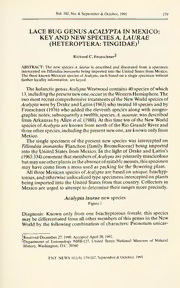
Lace bug genus Acalypta in Mexico: key and new species A. laurae (Heteroptera: Tingidae) PDF
Preview Lace bug genus Acalypta in Mexico: key and new species A. laurae (Heteroptera: Tingidae)
Vol. 102,No.4. September&October, 1991 179 LACE BUG GENUS ACALYPTA IN MEXICO: KEY AND NEW SPECIES A. LAURAE (HETEROPTERA: TINGIDAE)! RichardC. Froeschner^ ABSTRACT: The new speciesA. laurae is described and illustrated from a specimen interceptedon Tillandsiainonantha beingimported intotheUnited States from Mexico. ThethreeknownMexican speciesoiAcalypta,eachbasedonasinglespecimenwithout furtherlocalityinformation,arekeyed. The holarcticgQnnsAcalypta Westwood contains40 species ofwhich 13,includingthepresentnewone,occurintheWesternHemisphere.The two most recentcomprehensivetreatmentsoftheNewWorld speciesof AcalyptawerebyDrakeandLattin(1963)whotreated 10species andby Froeschner (1976) who added the eleventh species along with zoogeo- graphicnotes;subsequentlyatwelfth,species,^,susanae,wasdescribed from Arkansas byAllen etal. (1988). At this time ten ofthe NewWorld species oiAcalypta are known from north ofthe Rio Grande Riverand threeotherspecies,includingthepresentnewone,areknownonlyfrom Mexico. The single specimen ofthe present new species was intercepted on Tillandsia inonantha Planchon (family Bromeliaceae) being imported into the United States from Mexico. In the light ofDrake and Lattin's (1963:334)commentthatmemberso{Acalypta areprimarilymuscicolous butmayuseotherplantsintheabsenceofsuitablemosses,thisspecimen may have come from a moss used as packing for the flowering plant. All three Mexican species o^Acalypta arebasedon unique,brachyp- terous,andotherwiseunlocalizedtypespecimens interceptedonplants being imported into the United States from that country. Collectors in Mexico are urged to attempt to determine their ranges more precisely. Acalypta laurae new species Figure 1 Diagnosis: Known only from one brachypterous female, this species may be differentiated from all other members ofthis genus in the New World by the following combination ofcharacters: Pronotum unicar- ^Received December27, 1990.AcceptedApril20, 1991. ^Department of Entomology NHB-127, United States National Museum of Natural History,Washington, D.C.20560 ENT. NEWS 102(4): 179-182.September&October, 1991 ENTOMOLOGICALNEWS 180 inate; headwith a pairoflong, separated frontal spines; and hypocosta uniseriate. InDrakeandLattin's(1963:335-336)"KeytotheBrachypterousFormsof AimericanAcalypta, "A. lauraerunsXoA.mniophilaDrakeandRuhoffbut can be distinguished therefrom by possession ofa pairoflong, frontal spines.InFroeschners(1976:267)keytotheAcalyptaknownfromMexico,it runs toA. ruhojfae Froeschner but can be separated by any one ofthe followingcharacters:thepresenceoflong,wellseparatedfrontalspines; thewhollyuniseriatehypocostallamina;ortheunicoloreddarkveinsof the hemelytra. Description: Measurements in millimeters. Brachypterous female holotype. Broadly ovate,widestslightlyposteriortomidlength.Colordarkfuscousbrown;veinsseparating discoidalandcorialareasconcolorouswithveinswithinthoseareas.Ventrallydarkwith bucculae,baseofhemelytron,and marginsofcoxalcavities noticeablypaler. Headwith frontal spineslong,diverging,slightlysurpassingapex. Bucculaeanteriorly distinctlyincurved,notcontiguous.Antennophorestraight,blunt,attainingmidlengthof antennalsegmentI.Antennalsegmentalproportions,I-IV,0.11 :0.08:0.39:0.17;segment III slender, noticeably wideronbasal sixth. Pronotumwithweaklytectate,bluntlytriangular,anteromedianprojectionabovehead; paranotumalmosttwiceaswideasaneye,triseriate,lateralmarginconvex;mediancarina irregularlyuniseriatein middlethird,then lowertoward each end; lateralcarinaeabsent. Costalareacellsprominent, mostlyquadrate,uniseriateexcept foroneortwodivided cells at base and nearapical fourth; outerlimitingveins ofdiscoidal areas coarctate in basal third,in lateralviewstronglyelevated andconvexalonganteriortwo-thirds; inner limiting vein of discoidal area becoming evanescent basally. Hypocostal lamina uni- seriate. Length 2.07. Holotype: Brachypterous female, "intercepted on leaf of Tillandsia ionantha from Mexico; Tex., Brownsville, Feb. 19, 1988, D. Riley." De- posited in the National Museum of Natural History, Smithsonian Institution, Washington, D.C. ThenameofthisspeciesdedicatesittoMs.LauraTorresMillerwhose dissertation formed the basis forthe revision ofMexican tingid genera by Brailovsky and Torres (1986). Key to brachypterous Mexican Acalypta 1. Headwithapairoflongfrontalspinesexceedingapexofhead.Paranotumwith3rows ofcells 2 Headwithoutprominentfrontalspines. Paranotumwith2 rowsofcells mniophila Drakeand Ruhoff 2. Frontalspinesdistinctlyseparated. Hypocostawhollyuniseriate.Outerlimitingveins ofdiscoidal areaconcolorouswith veins indiscoidal and subcostal areas lauraenewspecies Frontalspinesvirtuallycontiguousforfulllength. Hypocostabiseriatebasally.Outer limiting veins ofdiscoidal area conspicuously darker than veins in discoidal and subcostalareas ruhoffaeFroeschner Vol. 102,No.4. September&October, 1991 181 Fig. 1. HabitusoiAcalyptalaurae,n. sp. ENTOMOLOGICALNEWS 182 ACKNOWLEDGMENTS SpecialthanksareduetoElsieH.Froeschnerforthefinehalftonehabitusdrawing,to ThomasJ. Henry.U.S. DepartmentofAgriculture, Systematic EntomologyLaboratory, andOliverS.Flint,Jr..NationalMuseumofNaturalHistoryforreviewingthemanuscript andmakinghelpfulsuggestions. LITERATURECITED Allen,R.T.,C.E.Carlton,andS.A.Tedder. 1988.AnewspeciesoiAcalypta(Hemiptera, Tingidae)fromArkansas.J. Kansas EntSoc,61(1):126-130. Brailovsky,H.,andL.Torres.1986.Hemiptera-HeteropteradeMexicoXXXVI.Revision genericadelafamiliaTingidaeLaporte.An.Inst.Biol.Univ.Nal.Auton.Mex..56,ser. Zool..(3):869-932(1985). Drake, CJ., and J.D. Lattin. 1963. American species ofthe lacebug genus Acalypta (Hemiptera:Tingidae). Proc. U.S.Nat. Mus., 115:331-345. Froeschner,R.C. 1976.Zoogeographicnotesonthelacebuggenus^ca/y/jraWestwoodin theAmericas with descriptionofa newspecies from Mexico(Hemiptera:Tingidae). Amer. Midi.Nat..96(2):257-269.
